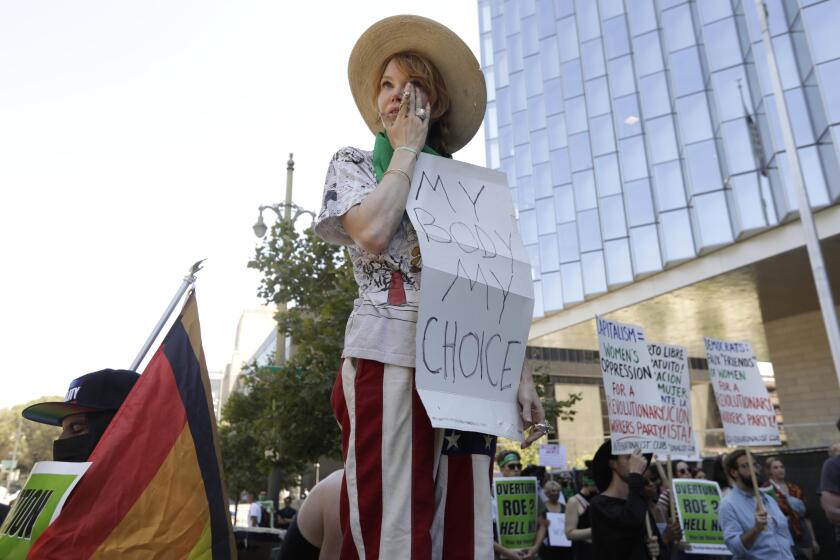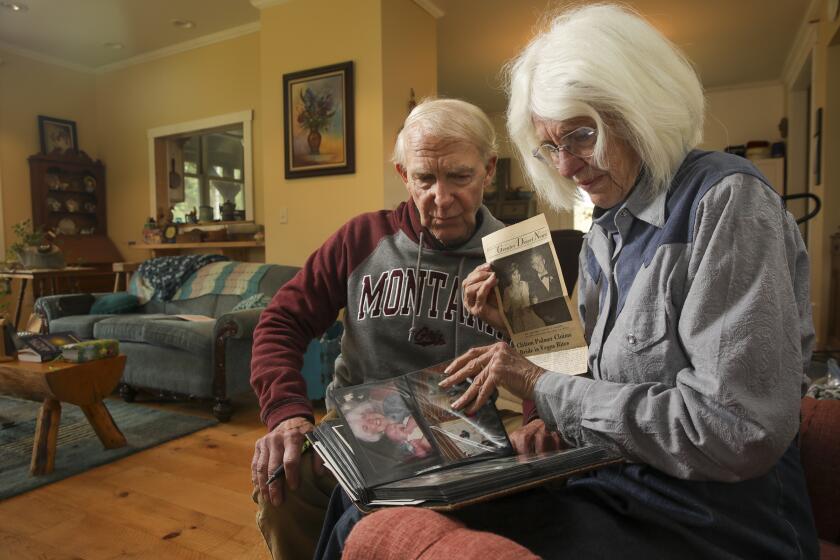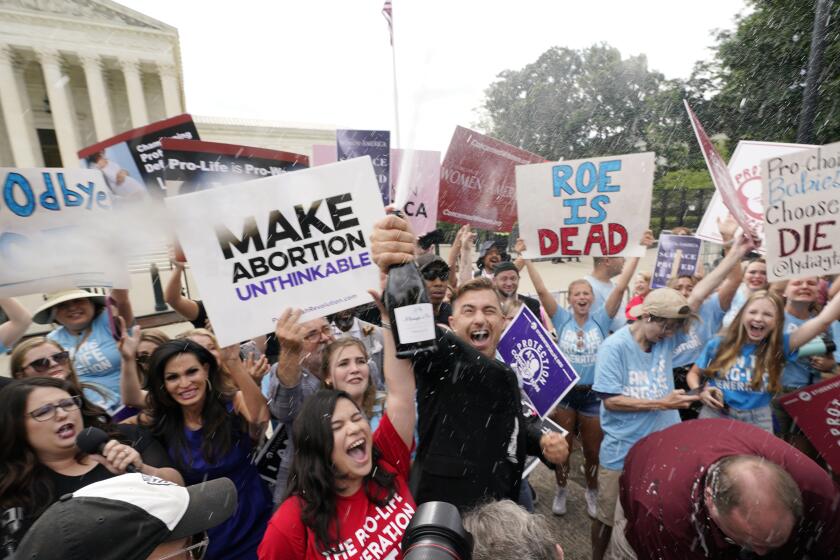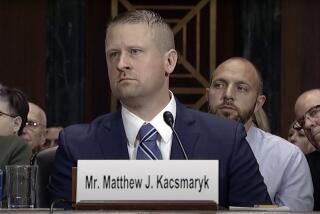The woman who brought down Roe vs. Wade wants to take abortion battle to California

- Share via
ATLANTA — Perhaps more than any other woman, Marjorie Dannenfelser is responsible for the fall of Roe vs. Wade.
The president of Susan B. Anthony Pro-Life America, a nonprofit group that works to end abortion in the United States by electing antiabortion politicians, Dannenfelser has dedicated her adult life to outlawing abortion. In 2016, she played a key role in getting President Trump to commit to appoint U.S. Supreme Court justices who oppose abortion.
Protesters rally across Southern California after the Supreme Court overturned Roe vs. Wade.
The Los Angeles Times asked Dannenfelser, 56, about the fall of Roe, her antiabortion journey and her strategy for outlawing abortion nationwide. This interview has been edited for clarity and length.
After decades working in antiabortion politics, you are watching Roe vs. Wade fall. In what sense is this a historic moment?
It’s the culmination of almost 50 years of work. There was no certainty that this moment would come at all. But every single time there’s a failure or a setback, this movement has grown. And that is a marker of an authentic human rights movement: It draws more in difficulty than it does in success sometimes.
You’ve written: “No other issue, however worthy, carries a moral weight equal to that of the unborn child in the womb.” How did you get from being a pro-choice Republican to believing that abortion is about human rights, not women’s rights?
I grew up in fairly polite society. You just didn’t think or talk about this issue. I think that polite society has kept the harsh reality of that human rights violation away from the public eye and from one individually. So I never thought about it. I knew that I would have [an abortion] if I needed one. I just considered it part of living.
A 22-year-old woman and an abortion doctor from California played key roles in the legal fight that led to Roe vs. Wade, now struck down.
But that ability to keep what an abortion is out of your thoughts, out of your mind … when I approach the reality of what the object of the abortion is, and then what happens in an abortion, I mean, it is really hard to ignore the reality of a procedure that tears a small human apart limb from limb. It’s that — imagining the too horrible to imagine — that finally set my thoughts in process.
In college at Duke, I started pre-med and ended up in philosophy. I had a lot of friends who were very pro-life. They showed a movie on campus, “The Silent Scream” narrated by Dr. Bernard Nathanson, a prolific abortionist who changed his mind to being pro-life. He showed an abortion through a sonogram, and you could see what was happening. I remember I was like, “That is just insulting. I am not going to watch that.” But I had these conversations with people peppering me with difficult questions: “What happens in an abortion?” “What is the object?”
Though abortion will remain legal in California, residents across the state expressed outrage at the Supreme Court’s reversal of Roe vs. Wade.
Like, if you’re getting your appendix out, that’s the object. If you’re getting your tonsils taken out, that’s the object. What is the object in an abortion?
Taking stock of the last few decades, how was Roe undone? What were the key turning points? How pivotal was 2016, when you got President Trump to commit to nominating justices who opposed abortion?
All of a sudden, in Jan. 22, 1973, there is a need for a huge movement, because every single pro-life law has been wiped off the books by the Supreme Court. So we required some sort of strategy quick, without any grass roots, just a handful of people. So that first wave was figuring out: “Oh, we need a movement and what do we do?”
In the second wave, the movement started to grow. It built pregnancy help centers trying to reach women to help them at that moment in their lives. There were all sorts of education campaigns. The organic movement grew and grew, but silently in communities and towns and churches all over the country.
Then, in 2012, came the third wave. We decided to very strategically put this at the center of politics: prove the case that this is not only the right thing to do, but the politically smart thing to do, by drawing a contrast between what the other side has achieved, absolute abortion on demand up into the end, paid for by everybody, versus what our candidates were advocating for: some compromise, like a 20-week limit. Such a limit has massive support in every demographic, except for the most hardcore left.
I had grown up thinking that abortion was immoral, that anyone who had one would burn in hell. But I immediately saw the film for what it was: propaganda.
We started to ask presidential candidates to make a pledge of action. With the pledge, it became a primary debate among all the Republican primary candidates: Who’s the most pro-life? That’s exactly what you want. Then when it came to Trump: The commitment from him — because there was so much doubt about who he was and what he would do — was vital. It really came down to a letter from him to me in the pro-life movement, pledging what he would do concretely if he were the president of the United States. So many people didn’t take it seriously, because nobody thought he was gonna win. But he did.
You attribute part of your success to compromise — promoting 20-week limits — but surely your ultimate goal isn’t compromise? It’s to outlaw abortion across the United States? You’ve spoken privately with possible Republican presidential contenders, including Trump, about a federal ban.
Now the door is open, so of course we will walk through it. After nearly 50 years, this is an opportunity to allow the people to speak through their laws through their elected representatives. And so every legislature in the country, including Congress, is now entrusted with this really heavy moral weight to get it right. And so we will be as ambitious for life and for mothers in every single state as consensus will allow.
We will build broad support for the most protective laws for unborn children and assistance for their mothers in every single state. That’s about 30 states where it’s in play and 20 where there’s very little chance and it would require federal legislation. But it’s the same approach for the U.S. Congress, which is not Alabama. It’s very complicated and it requires a president and a Congress that can utter the word “compromise.”
What do you say to the many women who will now take to the streets to protest, upset that the government is making a decision for women that violates their bodily autonomy?
Peace is going to be found. When we, as a country, serve women as they deserve to be served, we don’t make them choose, or we don’t influence them to choose one over the other. We serve both woman and child — and serving them both is going to require a lot out of us. I believe that we can do it together.
We now face abortion outlawed or severely restricted in 26 states, with women traveling to blue states or managing their own abortions. How do you expect the battle to play out in the coming weeks and months?
I expect there will be immediate trigger laws or formerly passed laws that will be allowed to go into effect right away. It might take a few days, but there will be certainly quite a number of states that’ll have laws on the books that reflect what the state actually voted on. But then there are about eight states where it’s going to be far more protracted. In Kansas, there’s a constitutional restriction on pro-life laws, so we have a ballot initiative in August asking the question: Will Kansans be allowed to make their own law on this issue?
With polls showing about six out of 10 Americans oppose overturning Roe, do you anticipate that there’ll be a major backlash for Republicans in November?
No, not based on that. That statistic tells you very little because the American public doesn’t understand what Roe is. Also, the polls show that people want restrictions that Roe does not allow. During the debates, when these elections center around what the will of the people is, then we win.
The majority of Democrats think that abortion should be restricted to just the first trimester. That is absolutely, completely contradictory of Roe v. Wade. There is only one place that the abortion lobby will allow its candidates to go and that is every abortion up until the end, paid for by you and me. That’s it.
But have you really won the argument with the public? Your critics argue that your victory was achieved by pushing a president, who did not win the popular vote, to appoint Supreme Court justices.
Roe was a conversation ended — a complete cap on the ability to do something by the Supreme Court. That was not winning over anybody’s opinion; that was saying your opinion counts for nothing. Now is a moment when your opinion counts for something. And when you look at what we know about what people think already, we know that most of the argument is already won: abortion after the first trimester is rejected in certainly every battleground state.
But your aim is to see abortion banned across America — in states such as California and New York?
Well, if you think that every abortion is the death of a child — like I do — you definitely want to save every child. And serve every mother.
Among antiabortion groups, is there consensus on the path forward? What are the key debates within your movement?
There is more unity in this movement now than I’ve ever seen. But there used to be one front in this battle, now there are 51, and if you include the territories, even more. And so the wheels of democracy are spinning. In each state, there’s a different blueprint. On the national and state level, I have a job to do and that is answering the question: How ambitious can we be here? And what do we need to do to reach that ambition?
Do you think states should do more to criminalize abortions, by prosecuting people who help women travel to other states or access medication abortions? What about prosecuting women themselves?
Never will I support prosecuting women. Susan B. Anthony talked about the evil that abortion is and that the answer is to get to the root causes. The root causes are the people that are feeding off our misery, the people who exploit our situation for money, and the people who circumvent the law by sending pills in the mail. That is a RICO violation. And those are the people that we will go after. When you conspire to break the law, you deserve to be penalized, you deserve to have your medical license taken away, you deserve to have your corporate privileges suspended.
That will never be on the back of the woman who needs and deserves more than she’s receiving from this group of people who give her one thing when she’s in crisis: a pill and a lonely room with no help, no doctor supervision, no real plan for what will happen if she hemorrhages.
You’ve done all this work to stop women from getting abortions. What are you doing to help women in red states who get pregnant and may not have the financial resources and support to care for their children?
We’ve been working on a particular program for the last few years [Her Pregnancy and Life Assistance Network, or Her PLAN, which aims to help pregnant women find the medical and material support they need to continue pregnancy]. I’ve talked to, so far, 22 governors about the need to meet women where they are and make sure that we are comprehensive in how we serve them.
What we’ve done so far with our allies in four states [Georgia, Mississippi, Virginia and West Virginia], and hope to do in 30 in four years, is comprehensive and massive inventories to make sure that women and children in the first two years of the child’s life have access to seven different points of care. They include serving her if she is addicted, serving her if she has no housing, serving her and her child if she has no healthcare or childcare.
Serving what her particular needs are, without taking the life of her child. Affirming her life and affirming the life of her child by believing in her and helping her build instead of undermining her life.
More to Read
Sign up for Essential California
The most important California stories and recommendations in your inbox every morning.
You may occasionally receive promotional content from the Los Angeles Times.















